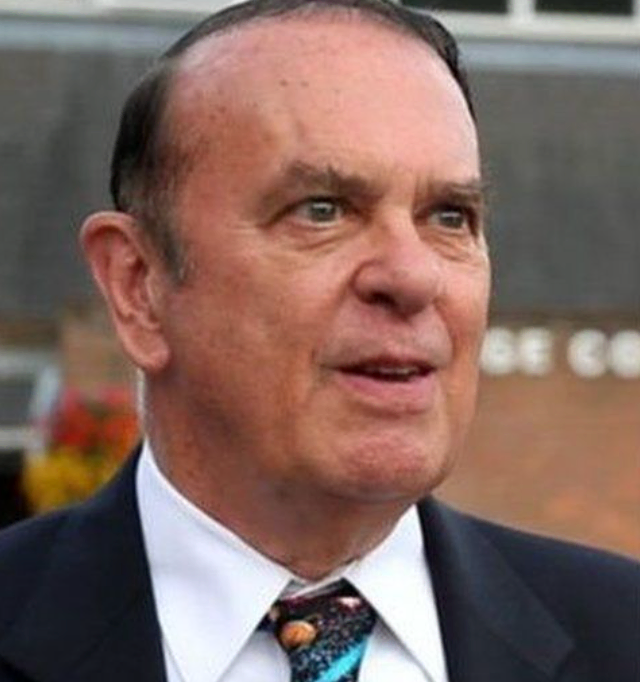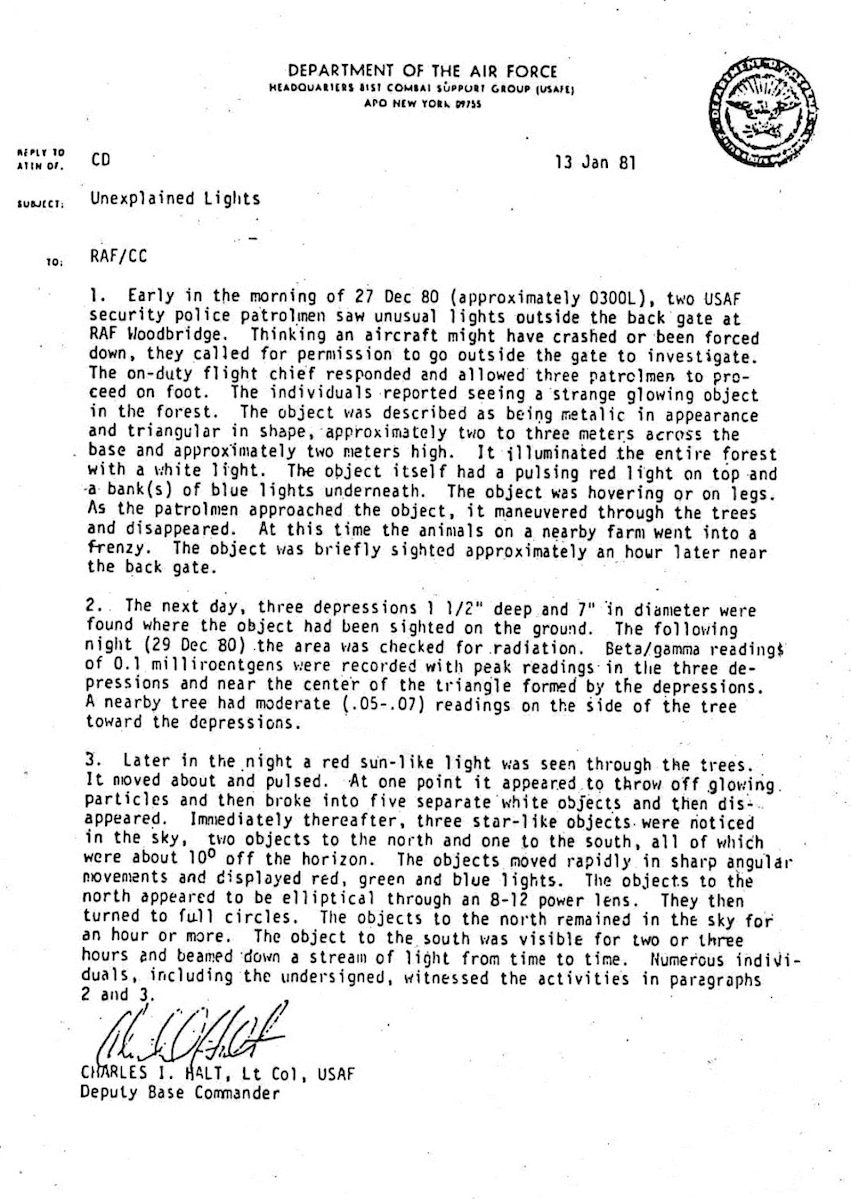
Summary
The Halt memo and tape were two pieces of evidence from an incident that is referred to as the “U.K. 's Roswell,” or Rendlesham for short. The UAP incident took place in Rendlesham Forest in Suffolk, England, in December 1980. Rendlesham involved a series of reported sightings of unexplained lights and aircraft, which happened just outside an airforce base used by the United States Air Force. One of the key witnesses to these events was Lieutenant Colonel Charles I. Halt, a U.S. Air Force official who had been deployed to the U.K’s twin RAF bases Bentwaters and Woodbridge. His witness tapes of the events, and his subsequent memo, which was sent to his superiors are some of the most well-known witness reports in the history of UAPs.
The Incident
At around 3 a.m. on December 26, 1980, two U.S. Air Force members on security patrol saw “unusual lights” from the east gate of RAF Woodbridge. Believing them to be from an aircraft that may have crashed or been forced to land, they asked for permission from the on-duty flight chief to investigate. Three patrolmen were sent to explore the area, and reported seeing a “strange glowing object” in the forest.
As the patrolmen neared the object, it reportedly maneuvered through the trees and disappeared from sight. Animals on a nearby farm went into a frenzy, and the object was spotted again an hour later near the back gate of the airbase.
Sergeant Jim Penniston, who was one of the patrolmen at the scene, later claimed that he had encountered a "craft of unknown origin", but there was no publicized mention of this at the time.¹
At around 4 a.m. local police were called to the scene. They reported that the only lights visible were from the Orford Ness lighthouse. A letter from the then-Chief Constable Inspector Mike Topliss to an individual who appears to have been enquiring about the incident described two visits to the location after receiving a call from someone at RAF Bentwaters.
The next day, Air Force personnel, including Halt, returned to the area. Halt recorded the second visit on a micro-cassette recorder. The group said they saw another light, this time pulsing with a red “sun-like” glow through the trees. The light was reported to disperse glowing particles and then broke off into five separate white objects before disappearing. Immediately after the red light was spotted, personnel on the airbase sighted three more star-like objects in the sky. They moved rapidly in sharp angular movements and displayed red, green and blue lights. Many of the witnesses signed the commander’s report to confirm their accounts. The witnesses watched the objects through a lens and reported them to be elliptical at first, but then witnessed the shapes turn into full circles. The UAP in the north was visible for around an hour, while the two UAPs in the south were visible for between two and three hours, and occasionally beamed down a stream of light.²
In 1984, the recording known as the “Halt Tape” was released to the public by Colonel Sam Morgan, who was by then Halt’s superior following a freedom of information query.
Highlights of the tape included audio of witnesses describing on-the-scene accounts with a security official, very strange noises by the neighboring farm, abrasions to the trees with sap being collected for samples, and readings being taken by a geiger counter.
The counter was being operated by Sergeant Monroe Nevels, who was a Chemical Defense Instructor in Disaster Preparedness, and not a nuclear specialist. His unfamiliarity with the equipment becomes apparent later in the tape. Other voices heard belong to Bruce Englund, who is guiding Halt around the site and who points out the flashing lights from the UAP. Englund has never spoken to the media about the events of that night.
After the strange noises were heard by the barn, Englund pointed out a light to Halt: “Right on this position here. Straight ahead, in between the trees – there it is again. Watch – straight ahead, off my flashlight there, sir. There it is.”
“It’s a strange, small red light, looks to be maybe a quarter to a half mile, maybe further out….There is no doubt about it – there’s some type of strange flashing red light ahead… I saw a yellow tinge in it, too. Weird! It appears to be maybe moving a little bit this way? It’s brighter than it has been…It’s coming this way. It is definitely coming this way,” Halt said on the tape.
Englund and Nevels both join in describing the light’s movements, describing that “pieces of it are shooting off” and that there are “two lights - one light just behind and one light to the left”.³ Halt orders the men to keep their flashlights off as there’s “something very, very strange” happening.
The group takes turns using an AN/PVS-2 Starscope – a monocular that amplifies light by around 1000 times, and magnifies by four times – and describes the light as “a pupil of an eye”. Halt adds it is as if it is “looking at you, winking”, and “the flash is so bright on the Starscope that it almost burns your eye”. Colonel Halt then points out that there are multiple sightings of as many as five lights, in addition to a light “right on the horizon” that “moves about a bit and flashes from time to time” and is red in color. At 3.05am, Halt reports “two strange objects, half moon shape, dancing about, with colored lights”.
At the end of the tape, Halt observes “what appears to be a beam coming down to the ground”. “Colors!” an unidentified voice shouts out, to which Halt laughs, and adds: “This is unreal”.

On January 13, 1981, Halt submitted a memo to the U.K.’s Ministry of Defense, which was titled “unexplained lights”. The memo was eventually made public in the United States in 1983 following a Freedom of Information Act request that also released the tape.
Retired Sergeant John Burroughs stated that the events took place over three successive nights, beginning December 24, and ending on December 27. However in Halt’s memo, Halt notes that the first sightings were on the night of the 26th–27th. Halt also describes seeing the UAP on the morning of the 29, but later analysis points to the incident taking place in the early hours of the 28th. The memo was written more than two weeks after the event took place and Halt later agreed that he had probably made a mistake in his recollection of the dates. The one page report was written on official US Air Force-headed notepaper but was not classified, and can still be viewed by members of the public at The National Archives in Kew, west London.
The memo described the events of the incident two weeks prior, and notes that there were “numerous” witnesses to the activities mentioned in the memo. Dr. David Clarke, a UAP expert, conducted an investigation in 2010, looking into the actions that were taken by the MoD following the receipt of Colonel Halt’s memo. Clarke interviewed Colonel Halt’s boss Colonel Conrad, the UK base commander Donald Moreland, and Simon Weeden, who was on the MoD’s UAP desk. He revealed that a cursory investigation was conducted, but the MoD regarded the letter of little importance, not even interviewing the witnesses. No further official report was made.³
The Ministry of Defense denied the event posed any threat to national security, and stated that it was therefore never investigated as a security matter. Later, it emerged that there may have been a substantial MoD file on the subject, but when the file was released in 2001, it turned out to consist mostly of internal correspondence and responses to inquiries from the public. ⁴